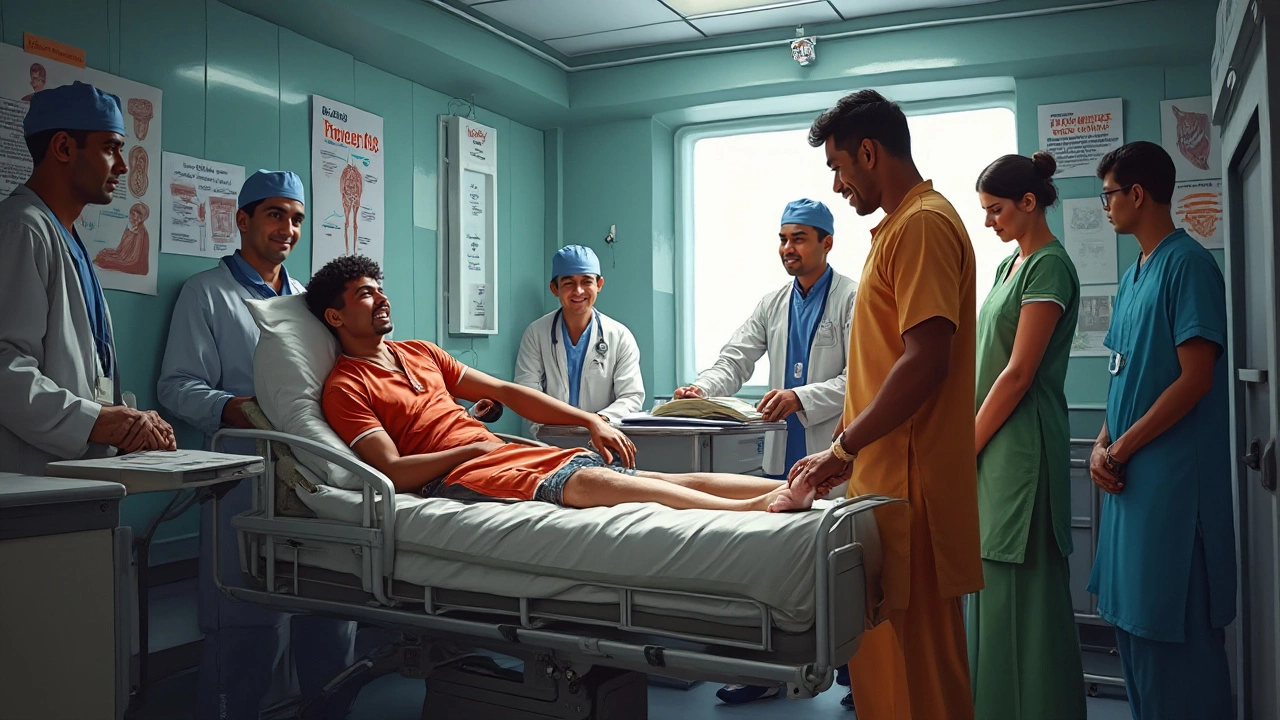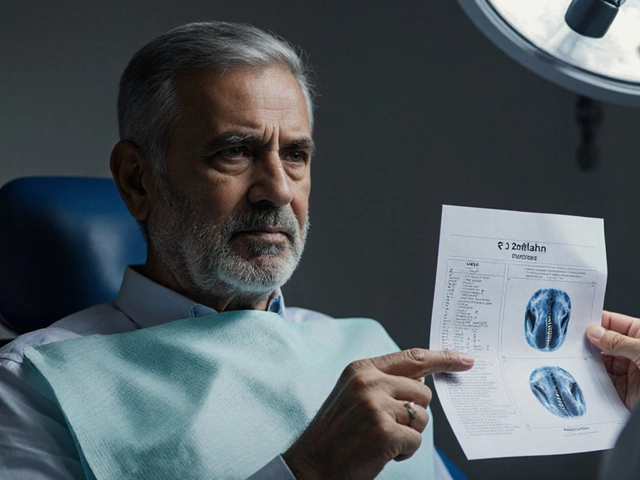When discussing orthopedic emergencies, one word springs to mind for many medical professionals: fractures. Known for their sudden onset and often excruciating pain, fractures are not just frequent but also varied in nature, affecting everything from fingers to the formidable femur. Given the high stakes associated with these injuries, understanding their dynamics goes a long way in ensuring timely and effective treatment.
Why are fractures so prevalent in the realm of orthopedic emergencies? For starters, our active lifestyles increasingly lead us into scenarios—be it a bustling city street or a weekend hike—where the risk of accidental falls or injuries looms large. But it isn't just the adventurous among us; age and even mundane activities can predispose individuals to these bone-breaking conundrums.
- Prevalence of Fractures
- Causes and Risk Factors
- Initial Management and First Aid
- Importance of Immediate Care
- Prevention and Recovery Tips
Prevalence of Fractures
When it comes to the realm of orthopedic emergency, fractures hold the unenviable title of being the most common incidents requiring urgent care. Studies have shown that fractures account for a significant proportion of all orthopedic emergencies worldwide, with incidences fluctuating across various demographics and environments.
To illustrate, hip fractures are notably widespread among the elderly due to falls, with over 300,000 cases reported annually in countries like the United States alone. Lower limb fractures, including those of the tibia and fibula, are also prevalent, particularly among younger adults involved in high-impact sports and vigorous activities.
Age and Fracture Patterns
Age plays a crucial role in the occurrence of fractures. While children are prone to wrist and forearm fractures, often from playful follies, adults nearing their golden years suffer more from hip and pelvic fractures due to osteoporosis. Osteoporosis, a condition characterized by reduced bone density, significantly elevates the risk of fractures even with minimal impact.
Gender Disparities
Gender differences in fracture prevalence have also been reported. For instance, women, particularly post-menopausal, are at a higher risk of sustaining fractures compared to their male counterparts, attributed to changes in hormonal levels affecting bone density. Conversely, men often experience fractures through work-related injuries and contact sports.
Global Incidence Rates
| Region | Annual Fracture Incidents |
|---|---|
| North America | 4 million |
| Europe | 5 million |
| Asia | 2.8 million |
| Australia | 500,000 |
These statistics underscore the widespread nature of fracture occurrences, highlighting the critical need for prepared and well-equipped orthopedic hospitals to manage these cases effectively.
Understanding the prevalence of fractures can inform better resource allocation for healthcare institutions, ensuring swift response and effective treatments for these common yet impactful emergencies.
Causes and Risk Factors
Fractures, as the most common orthopedic emergency, have a multitude of causes, often rooted in the interactions between external forces and the inherent strength of bones. The human skeleton, albeit robust, can yield under sufficient stress or compromised conditions.
Common Causes
Accidents, whether vehicular or from falls, top the list when it comes to the most frequent causes of fractures. Sports-related injuries, from high-impact games like football and rugby to simple weekend activities, also contribute significantly to fracture statistics. Furthermore, occupational hazards, especially in construction and manual labor jobs, frequently put workers at risk.
Pathological Fractures
In some cases, bones weakened by disease can fracture under minimal stress. Osteoporosis, a condition prevalent in elderly populations, particularly women post-menopause, leaves bones fragile and more likely to break even from minor falls. Other conditions like bone cancer and disorders that affect bone metabolism, such as Paget's disease, also drastically increase fracture risk.
Risk Factors
The probability of experiencing a fracture is influenced by several intrinsic and environmental factors. These often include:
- Age: Young children and the elderly have higher fracture risks due to developing and aging skeletal structures, respectively.
- Bone Density: As bone density diminishes, particularly in patients with osteoporosis, fracture susceptibility rises.
- Physical Activity Levels: Both a sedentary lifestyle and excessive physical engagement without proper precautions can elevate fracture risks.
- Nutritional Deficiencies: Inadequate intake of calcium and vitamin D can adversely affect bone health.
- Genetics: A family history of bone diseases or conditions that affect bone strength may predispose individuals to fractures.
Astoundingly, according to a recent analysis, falls account for an astounding percentage of hip fractures in the elderly population, underscoring the critical need for preventive strategies.
Environmental and Lifestyle Factors
While genetic predispositions play a role, lifestyle choices are critical in fracture prevention. Smoking, excessive alcohol consumption, and lack of weight-bearing exercise can reduce bone strength over time. Awareness and modification of these lifestyle habits can significantly lower fracture odds, fostering better long-term orthopedic health.

Initial Management and First Aid
The immediate response to a suspected orthopedic emergency like a fracture can significantly influence the recovery trajectory. Recognizing the signs early and taking correct initial actions are paramount. These preliminary steps are not just common sense; they are backed by medical best practices to prevent further injury and ensure swift professional care.
Recognizing a Fracture
Identifying a fracture isn’t always straightforward. Typical signs include intense pain at the injury site, swelling, and visible deformity. Sometimes, there's a loss of function or an unusual angulation of the limb. Even if the fracture isn't visible, an audible snap or crack at the time of injury is a strong indicator.
Immediate Steps to Take
If you suspect someone has incurred a fracture, here are the critical steps you should follow:
- Keep Calm: Panic can exacerbate the situation. Staying calm helps in providing clear instructions and making sound decisions.
- Prevent Movement: Immobilize the injured area without attempting to realign the bone. Use a splint where possible.
- Apply Cold Compression: Ice packs can help reduce swelling and numb the pain. Wrap the ice in a cloth to avoid direct contact with the skin.
- Elevate the Limb: If possible and it doesn’t cause additional pain, elevate the injured area above the heart level to reduce swelling.
- Seek Professional Help: Contact emergency services or head to the nearest orthopedic hospital for a detailed assessment and treatment.
Why First Aid is Critical
The right first aid can minimize the risk of complications such as nerve damage or further bone displacement. Studies suggest that proper initial care can reduce recovery time by up to 20%. Here’s a glimpse:
| Type of Fracture | Complication Reduction |
|---|---|
| Simple Fractures | 20% |
| Compound Fractures | 15% |
| Comminuted Fractures | 10% |
Knowing When to Call for Backup
It's crucial to recognize when you need more than basic first aid. If there's uncontrollable bleeding, if the patient is in shock, or if you suspect a spinal-related fracture, immediate professional intervention is non-negotiable.
In sum, understanding the essentials of emergency treatment for fractures enhances not only personal preparedness but also community resilience, ensuring that help, when needed, is swift and effective.
Importance of Immediate Care
In the realm of orthopedic emergencies, the swiftness of medical intervention can greatly influence recovery outcomes. When fractures occur, responding immediately is crucial in mitigating complications and reducing pain. This effectively emphasizes how necessary it is to prioritize instant care when dealing with bone injuries.
Preventing Further Damage
The human body is an intricate system where any disruption, such as a fracture, can easily lead to cascading issues. By seeking emergency treatment as soon as possible, further damage such as vascular injuries or nerve entrapment is less likely to occur. When bones are broken, surrounding tissues, muscles, and nerves can also suffer trauma, making it vital to address the trauma promptly to prevent any long-term disability or impaired function.
Reducing Pain and Swelling
Pain management is another critical component of immediate care. Fractures are often accompanied by significant pain, and reducing this pain quickly can help improve patient comfort, compliance with treatment, and morale. Immediate care often involves the use of splints or immobilizers to stabilize the injury, which not only helps in reducing pain but also minimizes swelling, promoting quicker healing.
Time is of the Essence
The timing of care can directly affect the healing process. For instance, in the case of a hip fracture, studies have shown that patients receiving surgery within 48 hours of injury typically experience shorter hospital stays and improved functional outcomes. Thus, the significance of swift care underscores a broader necessity: robust communication and transport systems for patients to reach orthopedic hospitals in the shortest possible time.
Statistics on Immediate Orthopedic Care
| Type of Fracture | Optimal Treatment Window | Improved Recovery Rate |
|---|---|---|
| Hip Fractures | Within 48 hours | 85% |
| Wrist Fractures | Within 24 hours | 78% |
The table above illustrates how adhering to recommended treatment windows can dramatically boost recovery rates. For any orthopedic emergency, including fractures, the sooner treatment is initiated, the better the prognosis.
Conclusion
Immediate care is not just about alleviating immediate distress. It's a cornerstone that shapes long-term results, striving to restore function, minimize complications, and ultimately improve quality of life. Let these statistics and insights serve as a reminder: when fractures strike, time truly is of the essence, and immediate action can make a world of difference.

Prevention and Recovery Tips
When it comes to managing orthopedic emergencies like fractures, prevention is always better than cure. While accidents are often unpredictable, understanding the associated risk factors can significantly reduce their occurrence. Furthermore, effective recovery strategies can make a world of difference in terms of healing.
Understanding Risk Factors
Knowledge is power. While you can’t control everything, being aware of environmental and health-related risk factors can help mitigate the chances of a fracture. For the elderly, whom statistics show have an increased risk due to osteoporosis, regular bone density screenings are advisable. Athletes, on the other hand, should focus on proper nutrition and training techniques to avoid stress fractures.
Practical Prevention Strategies
- Home Safety: Especially crucial for older adults, ensuring a safe home environment can prevent falls. This includes securing rugs, installing grab bars in bathrooms, and using adequate lighting.
- Physical Fitness: Keeping muscles strong and flexible with regular exercise can improve balance and coordination, reducing fall risk.
- Nutrition: Maintaining a balanced diet rich in calcium and vitamin D supports bone health.
- Footwear: Choosing the right footwear helps keep you stable, whether at home or during outdoor activities.
Recovery is Key
Just as important as preventive measures is the path you walk post-injury. Proper recovery protocols ensure that fractures heal correctly, preventing future complications.
Steps for an Effective Recovery
- Follow Medical Advice: Adhere to your physician’s guidelines regarding rest, immobilization, and physical therapy.
- Gradual Activity: As healing progresses, slowly reincorporate regular activities. Listen to your body, increasing activity levels without rushing.
- Physical Therapy: Engaging in recommended physical therapy helps regain strength and improve range of motion.
Recovery timelines can vary; however, dedication to a structured recovery plan often sees most individuals returning to full function. Remember, prompt attention to any complications is crucial. Reconsiders safety practices often, as this can further help avert future orthopedic emergencies.





